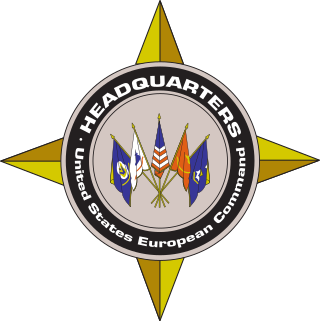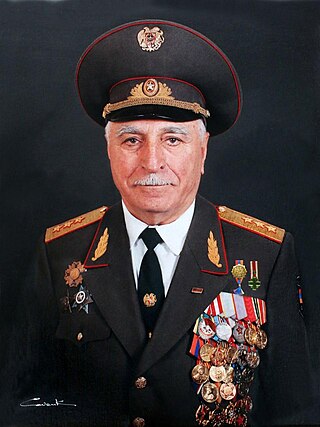
The Namibian Defence Force (NDF) comprises the national military forces of Namibia. It was created when the country, then known as South West Africa, gained independence from apartheid South Africa in 1990. Chapter 15 of the Constitution of Namibia establishes the NDF and defines its role and purpose as, " ... to defend the territory and national interests of Namibia".

A non-commissioned officer (NCO) is a military officer who does not hold a commission. Non-commissioned officers usually earn their position of authority by promotion through the enlisted ranks. In contrast, commissioned officers usually enter directly from a military academy, officer training corps (OTC) or reserve officer training corps (ROTC), or officer candidate school (OCS) or officer training school (OTS), after receiving a post-secondary degree.

The Commandos Marine, nicknamed Bérets Verts, are the special operation forces (SOF) of the French Navy, headquartered in Lorient, Brittany in western France. They operate under the Special Operations Command (COS), FORFUSCO, one of the four main forces of the French Navy or any operational command designated by the French Army staff. They specialize in offshore operations; operations from sea to land and special operations on land. One of the major characteristics of marine commando units is to be perfectly interoperable with all the resources and units of the navy.

The Goldwater–Nichols Department of Defense Reorganization Act of October 4, 1986 made the most sweeping changes to the United States Department of Defense since the department was established in the National Security Act of 1947 by reworking the command structure of the U.S. military. It increased the powers of the chairman of the Joint Chiefs of Staff and implemented some of the suggestions from the Packard Commission, commissioned by President Reagan in 1985. Among other changes, Goldwater–Nichols streamlined the military chain of command, which now runs from the president through the secretary of defense directly to combatant commanders, bypassing the service chiefs. The service chiefs were assigned to an advisory role to the president and the secretary of defense, and given the responsibility for training and equipping personnel for the unified combatant commands.

The Norwegian Armed Forces are the armed forces responsible for the defence of Norway. It consists of five branches, the Norwegian Army, the Royal Norwegian Navy, which includes the Coast Guard, the Royal Norwegian Air Force, the Home Guard, and Norwegian Cyber Defence Force as well as several joint departments.

Royal Air Force High Wycombe or more simply RAF High Wycombe is a Royal Air Force station, situated in the village of Walters Ash, near High Wycombe in Buckinghamshire, England. It houses Headquarters Air Command, and was originally designed to house RAF Bomber Command in the late 1930s. The station is also the headquarters of the European Air Group and the United Kingdom Space Command.

Allied Joint Force Command Brunssum (JFCBS) is a NATO command with its headquarters at Brunssum, the Netherlands. It was established in 2004, as part of a reorganisation that reduced the number of NATO Military Command Structure headquarters.

The United States Joint Forces Command (USJFCOM) was a Unified Combatant Command of the United States Department of Defense. USJFCOM was a functional command that provided specific services to the military. The last commander was Army Gen. Ray Odierno and the Command Senior Enlisted was Marine Sergeant Major Bryan B. Battaglia. As directed by the President to identify opportunities to cut costs and rebalance priorities, Defense Secretary Robert Gates recommended that USJFCOM be disestablished and its essential functions reassigned to other unified combatant commands. Formal disestablishment occurred on 4 August 2011.

The United States European Command (EUCOM) is one of the eleven unified combatant commands of the United States military, headquartered in Stuttgart, Germany. Its area of focus covers 21,000,000 square miles (54,000,000 km2) and 51 countries and territories, including Europe, The Caucasus, Russia and Greenland. The Commander of the United States EUCOM simultaneously serves as the Supreme Allied Commander, Europe (SACEUR) within NATO, a military alliance. During the Gulf War and Operation Northern Watch, EUCOM controlled the forces flying from Incirlik Air Base.
A unified combatant command, also referred to as a combatant command (CCMD), is a joint military command of the United States Department of Defense that is composed of units from two or more service branches of the United States Armed Forces, and conducts broad and continuing missions. There are currently 11 unified combatant commands, and each is established as the highest echelon of military commands, in order to provide effective command and control of all U.S. military forces, regardless of branch of service, during peace or during war time. Unified combatant commands are organized either on a geographical basis or on a functional basis, e.g., special operations, force projection, transport, and cybersecurity. Currently, seven combatant commands are designated as geographical, and four are designated as functional. Unified combatant commands are "joint" commands and have specific badges denoting their affiliation.
Air Command is the operational arm of the Royal Australian Air Force (RAAF). It is headed by the Air Commander Australia, whose role is to manage and command the RAAF's Force Element Groups (FEGs), which contain the operational capability of the Air Force. Headquarters Air Command is located at RAAF Base Glenbrook.

Bennie Luke Davis was a United States Air Force general who served as the commander-in-chief of Strategic Air Command, and as the director of Joint Strategic Target Planning Staff, with its headquarters at Offutt Air Force Base, Nebraska. The command was the major American nuclear deterrent force with bombers, tankers, reconnaissance aircraft and intercontinental ballistic missiles. The Joint Strategic Target Planning Staff coordinated United States nuclear war plans and develops the Single Integrated Operational Plan.

Gurgen Harutyun Dalibaltayan was an Armenian military commander. He was the Chief of General Staff of Armenian Armed Forces during the 1992 Battle of Shusha, a battle to capture the city from Azerbaijan. He is credited with devising a strategy to assault the strongly fortified town of Shusha using diversionary attacks against adjacent villages to draw out the defenders of the town while the commander of troops, Arkady Ter-Tatevosyan, encircled the town and cut off reinforcements. His strategy is generally considered impossible, or at least implausible, as he was originally outnumbered. General military tactics suggest a force of three times the defender's size to successfully storm and win.

Crosbie Edgerton Saint was a United States Army four-star general who served as Commander in Chief, United States Army Europe/Commander, Central Army Group from 1988 to 1992.

In the United States, commander is a military rank that is also sometimes used as a military billet title—the designation of someone who manages living quarters or a base—depending on the branch of service. It is also used as a rank or title in non-military organizations, particularly in law enforcement.
Progress Chef is a configuration management tool written in Ruby and Erlang. It uses a pure-Ruby, domain-specific language (DSL) for writing system configuration "recipes". Chef is used to streamline the task of configuring and maintaining a company's servers, and can integrate with cloud-based platforms such as Amazon EC2, Google Cloud Platform, Oracle Cloud, OpenStack, IBM Cloud, Microsoft Azure, and Rackspace to automatically provision and configure new machines. Chef contains solutions for both small and large scale systems.

The Action Division, commonly known by its predecessor's title Action Service is a division of France's Directorate-General for External Security (DGSE) responsible for planning and performing clandestine and covert operations including black operations. The core specialisations of the Action Division are sabotage, destruction of materiel, assassination, detaining/kidnapping, interrogation with and without using torture, infiltration/exfiltration of persons into/from hostile territory and hostage rescue.
The Composite Index of National Capability (CINC) is a statistical measure of national power created by J. David Singer for the Correlates of War project in 1963. It uses an average of percentages of world totals in six different components. The components represent demographic, economic, and military strength. More recent studies tend to use the (CINC) score, which “focuses on measures that are more salient to the perception of true state power” beyond GDP. It is still “among the best-known and most accepted methods for measuring national capabilities.” The CINC only measures hard powers and may not represent total national power.
Forces Command (FORCOMD) is the largest command within the Australian Army responsible for the combat brigades, the enabling and training formations reporting to the Chief of the Army with approximately 85% of the Army's personnel. The Command was formed on 1 July 2009 with the amalgamation of Land Command and Training Command, and is led by a major general as the Commander Forces Command.













